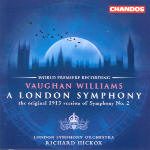Thanks to an enlightened decision by the composer’s widow, Ursula Vaughan Williams, we now have the opportunity to hear the original version of A London Symphony, containing nearly 20 minutes of music deleted from the revised edition published in the 1930s. Unlike the similar case of Sibelius’ Fifth Symphony, there are no major structural changes in the work’s overall form. The revisions consist almost entirely of cuts, each one of which appears to have been completely justified.
Although the booklet notes speak of the composer’s desire to make the work more “symphonic” (whatever this means) by tightening up its structure, I don’t think that’s quite the point. The cut passages do nothing to disorganize the form in their original places, but they do blunt the music’s emotional focus by damaging each movement’s distinctive character in one way or another. This has nothing at all to do with issues of thematic development because, except for the scherzo, all of the excised material is solidly based on existing tunes and motifs, and in the finale this actually solidifies (or at least explains) one aspect of its form more clearly than does the revision.
So what exactly are the differences? Here they are, in a nutshell:
The first movement has no changes at all. In the slow movement there’s an earlier version of the cadence theme (softly pulsating strings under a quiet horn call) that precedes the one we now know. Most significantly, however, the big climax cuts off suddenly for more extended, ruminating developments of the folk-like material that immediately preceded it. This leaves the movement without any real culminating point, and the revision vastly improves on the original version for precisely this reason despite the loveliness of the deleted passages. The scherzo sports a second trio–a gorgeously dark and sexy passage full of harp glissandos, flecks of glockenspiel, and a touching violin solo–that seems to come from one of the composer’s later works. Its air of nocturnal mystery already has been explored in the first two movements and will be again in the finale. Cutting this fabulous bit of orchestration must have been hard, but the fact is that if you hadn’t known it was there, you’d never miss it.
The finale begins as expected, but proceeds after the first allegro to a really ugly, chromatic development of its “cry of pain” introduction that sounds as if the hell music from Tchaikovsky’s Francesca da Rimini had stopped in for some fish and chips. Cutting this out was a no-brainer, even if it does offer an intriguing gloss on the movement’s opening gestures. From this VW works back along largely familiar paths to the big climax, inserting along the way an appealing but redundant calm interlude that looks back to (but does not actually quote) the contemplative music of the slow movement. A bit of this returns just before the chimes of Westminster softly herald the Epilog, which is substantially the same as the one we know, save for an extended reference to the work’s opening pages.
So you see, the 1913 version of A London Symphony is, in a sense, symphonically overdeveloped, and the composer’s intelligent pruning retains all of the important thematic substance while heightening the music’s contrast and emotional variety both within and between the movements. It was fun to hear once or twice, and the composer’s widow was absolutely correct in permitting this sole recording to gratify our curiosity, but also in maintaining her ban on live performances of the original version in consideration of VW’s own clearly stated final thoughts on a work he particularly loved.
Hickox and the London Symphony offer a very fine performance of the piece. The LSO brass have a field day, the strings sound uncommonly sensitive in those mysterious, pianissimo passages in the first movement development, and only an excessively prominent snare drummer who seems to think he’s doing the solo cadenza from Nielsen’s Fifth Symphony mars what are otherwise excellent balances throughout. Nevertheless, Chandos’ recording is not one of its best. It totally lacks deep bass, thus robbing the climaxes of much of their impact and depriving the important passages accompanied by quiet bass drum rolls of their sense of latent power. Even with very forward microphone placement and a wide dynamic range, something is clearly missing. A pity, then, but not enough to deter the curious, and Butterworth’s little idyll makes an apt, if unnecessary introduction to the symphony.
































